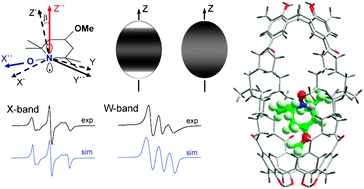Multifrequency continuous wave (cw) and echo-detected (ED) electron paramagnetic resonance (EPR) was employed to study the mobility of nitroxides confined in nanocapsules. The complexes p-hexanoyl calix[4]arene with 4-methoxy-2,2,6,6-tetramethylpiperidine-N-oxyl (MT) and N-(2-methylpropyl)-N-(1-diethylphosphono-2,2-dimethylpropyl)-aminoxyl (DEPN) were studied by X-, W-band and 360 GHz cw EPR at temperatures between 90 and 370 K. Thereby we were able to extract the canonical values of the hyperfine and g-tensors of the encapsulated radicals as well as information on restricted orientational dynamics of the caged spin probes. Comparing cw and ED-EPR data obtained on MT@C6OH we found that between 90 and 200 K the caged nitroxide undergoes isotropic small-angle fluctuations (librations), whereas at higher temperatures restricted rotations of the radical with correlation times of 0.75 × 10−10 s and 1.2 × 10−10 s dominate at 325 and 300 K, respectively. The activation energy of the rotational motion of encapsulated MT radicals was evaluated as Ea = 1.0 kcal mol−1, which is comparable to the magnitude of van der Waals interactions. Compared to MT, the reorientational motion of DEPN was found to be slower and more isotropic.

You have access to this article
 Please wait while we load your content...
Something went wrong. Try again?
Please wait while we load your content...
Something went wrong. Try again?


 Please wait while we load your content...
Please wait while we load your content...